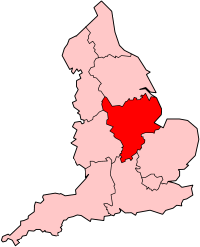
Beeston Hydro is a small hydroelectric scheme, in Beeston, Nottinghamshire. It is located on the River Trent, and generates up to 1.66 MW of electricity.
History
During 1999, Hyder Industrial Ltd. built the UK's largest "run-of river" hydro-electric plant at Beeston Rylands Weir. The plant was commissioned on 4 January 2000 and later sold on to United Utilities in 2001.
Description

The plant has a design life of twenty years. At the maximum consented flow rate, 60 m/s of water passes through the pair of turbines. Upstream of the weir and during the salmon migratory period, the plant utilises a bio-acoustic fish-fence—a bubble curtain in which the bubbles contain a sound that the fish do not like. This fish fence steers migrating fish away from the fast-flowing turbine intakes and into the fish ladder, by which the fish can safely negotiate the weir. The power generated supplies enough electricity (1.5 MW–1.66 MW) for two thousand homes, a total of 5.26 GWh annually, it is currently run by Infinis
References
- "Corporate Responsibility Report 04: Energy and climate change". British Land, United Utilities. 2004. Archived from the original on 3 November 2007. Retrieved 7 August 2008.
We have 11 hydro schemes across the UK including Nottinghamshire where we operate the UK's largest 'run-of river' hydro-electric plant on the River Trent at Beeston.
- Bacon, Ian; Davison, Ian (April 2004). "Low Head Hydro Power in the South-East of England – A Review of the Resource and Associated Technical, Environmental and Socio-Economic Issues" (PDF). pp. 101–103. Archived from the original (PDF) on 13 May 2008. Retrieved 7 August 2008.
An 80m long Bio-Acoustic Fish Fence (BAFF) is installed under the boom to guide juvenile fish towards the fish ladder. The BAFF produces a continuous stream of bubbles into which low frequency sound is inserted creating a localised sound curtain operating between 50 and 500Hz. This was the first time a BAFF had been approved by the EA and installed in the UK. The BAFF is only required to be switched on in spring and early summer. Downstream there is an electrical screen installed inside the exit of each draft tube, designed to repel upstream migrating fish from approaching the turbines and guide them towards the fishpass.
- "Viewports on Sustainable Energy in the East Midlands: Appendices" (PDF). East Midlands Regional Assembly. 30 September 2003. pp. 49, 79. Archived from the original (PDF) on 1 December 2008. Retrieved 7 August 2008.
O10 Notts. SK 535 353, Beeston Lock, Trent 1200 5.26 NFFO3; may increase to 1500 kW
- Mott MacDonald (November 2003). "Renewables Network, Impact Study, Annex 1: Capacity Mapping & Market Scenarios for 2010 and 2020" (PDF). The Carbon Trust & Department of Trade and Industry. Archived from the original (PDF) on 25 February 2009. Retrieved 7 August 2008.
Rung One Hydro Projects, Operational Beeston Weir Hydro Scheme, 1.66 , Nottinghamshire, England
- "Infinis - Our operations". Archived from the original on 14 October 2013. Retrieved 28 October 2013.
| Electricity generation in the East Midlands | ||||||||||||||||||||||||||||
|---|---|---|---|---|---|---|---|---|---|---|---|---|---|---|---|---|---|---|---|---|---|---|---|---|---|---|---|---|
| Power stations |
|  | ||||||||||||||||||||||||||
| Organisations | ||||||||||||||||||||||||||||
52°54′44″N 1°12′24″W / 52.912116°N 1.206626°W / 52.912116; -1.206626
Categories: